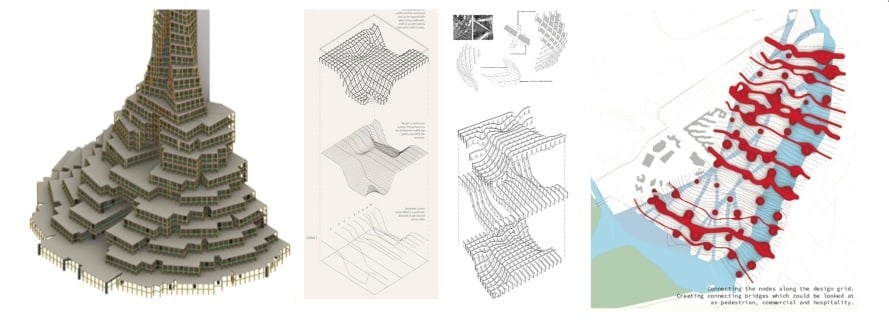-1.png)
The blueprint to your future may not look the way you imagined.
Let’s be honest. Architecture is one of those professions where your degree speaks volumes, but not always in the language the industry understands today. If you're an architect in India wondering whether a Master’s degree is your gateway to success, you're not alone. The dilemma is real, and it’s growing.
On one hand, the M.Arch (Master's in Architecture) carries prestige. The logical next step after your B.Arch (Bachelor of Architecture) is often more design, more research, and more specialisation. On the other hand, the industry is evolving at a pace that textbooks often can’t keep up with. Firms aren’t just looking for theoretical prowess anymore. They want skills that are relevant, sharp, and deployable now.
This blog is your guided walkthrough of everything you need to consider before jumping into a Master’s program in India. We’ll dissect the financial investment, time commitment, career outcomes, and whether the degree still holds weight in the industry. We’ll also look at the surge of short-term, skill-based alternatives, especially certificate programs that are fast becoming the go-to upskilling route for Indian architects.
Whether you’re a fresh graduate trying to make your next move or a working professional itching to level up, we’re going to help you answer this one crucial question:
Is an M.Arch still worth it, or is it time to redraw the plan?
Financial Implications of an M.Arch in India
M.Arch might seem like the right path forward, but it is also taxing, not just mentally but also financially. Here is your reality check!
Source: Money ain’t a hush topic!
Let’s talk about rupees and reality.
|
Expense Area |
Details |
|
Tuition Fees |
₹2–6 lakhs for the entire course at a reputable university. |
|
Living Costs |
₹10,000–₹25,000/month in metro cities like Delhi, Mumbai, or Bengaluru (includes rent, food, transport). |
|
Materials & Tech |
Studio supplies, high-performance laptop, licensed software — often essential and expensive. |
|
Internships/Research |
Many are unpaid, adding to the financial strain while offering a limited short-term return. |
|
Average Salary Post-M.Arch |
₹3–4.5 LPA is not a major jump from what a skilled B.Arch grad with relevant certifications might earn. |
|
Job Market Reality |
Roles with high ROI are limited to academia, government, or niche research positions. |
|
Student Loan Burden |
EMIs can be overwhelming in a field known for delayed payments and contract-based work. |
|
Time Investment |
2+ years, with no guaranteed financial leap at the end. |
|
Smarter Alternatives? |
Short-term certificate courses (like BIM or parametric design) often offer better ROI in less time. |
Time Commitment and Opportunity Cost
Two years. Twenty-four months. Over 700 days.
What else could you be doing?
A typical M.Arch program in India takes two full years to complete. That’s two years of lectures, research papers, studio work, projects, portfolios, critiques, and exams. Two years where you're likely not working full-time, not earning, and not gaining real-world experience. It's not just time…it’s time you could have spent building your portfolio, learning industry tools, or climbing the professional ladder.
This is what economists call an opportunity cost, and in architecture, it’s massive.
Let’s say you skip the M.Arch and instead spend those two years working with a design firm, freelancing, or learning advanced tools like BIM, Rhino, or Revit. By the end of that same period, you could have 2 years of work experience, a sharper skillset, and a much more appealing CV. You might already be earning what a fresh M.Arch graduate hopes to land.
Now consider this: the architectural industry in India is moving fast. Parametric design, sustainability practices, AI-assisted workflows, well, these trends aren’t waiting for anyone. And if you’re locked into a traditional curriculum that doesn’t evolve with market needs, you might find yourself graduating into irrelevance.
Of course, if your goal is research, teaching, or working abroad where a Master’s is often mandatory, then this time investment makes sense. But if you're aiming for hands-on design, cutting-edge tech, or faster career growth, those two years could be your launchpad instead of a pause button.
So the question becomes: do you want to study architecture, or practice it?
Curriculum Relevance and Industry Alignment
Are you learning architecture for 2030 or stuck in 1999?
Source: The future awaits
- Outdated Curriculum: Many M.Arch programs in India haven’t evolved to match the needs of the modern architecture industry.
- Theory-Heavy Approach: Courses focus heavily on research and theory that is good for academia or policy, but limiting for design practice.
- Limited Software Training: Critical tools like Revit, Rhino, Grasshopper, Navisworks, and BIM workflows are often missing from the curriculum.
- Lack of Real-World Exposure: Few opportunities for collaborative, interdisciplinary studio work that mirrors real-world practice.
- Teaching Gaps: Traditional lecture-based methods dominate, with little focus on tech-first, agile project workflows.
- Industry Expectations: Firms want architects who are digitally skilled, collaborative, and ready to contribute from day one.
- Academic vs Operational Value: An M.Arch still holds academic prestige, but may fall short in preparing students for real-world demands.
- The Risk: Without alignment to current tools and workflows, M.Arch graduates face a skills gap that can hinder job-readiness.
Career Prospects Post-M.Arch
More degrees. But does that mean more doors?
After two years, lakhs of rupees, and countless sleepless studio nights, you walk out with an M.Arch. Now what?
The assumption is that more education means better jobs. But in the architecture industry, that’s not always the case. While an M.Arch can boost your profile, it doesn’t automatically guarantee a better salary or position, especially in India’s fragmented architectural landscape.
Here’s the reality check: if you’re aiming for academic roles, the M.Arch is essential. It’s a ticket to become a professor, researcher, or even pursue a Ph.D. If you’re targeting government positions, heritage conservation roles, or urban planning in collaboration with civic bodies, this degree is often non-negotiable.
But for the average architect hoping to join a firm, lead design projects, or freelance independently, the M.Arch doesn’t always offer a clear advantage over a B.Arch, especially if the B.Arch comes with relevant skills and software certifications.
Many top-tier firms in India and abroad look beyond degrees. They want portfolios that demonstrate innovation, a strong grasp of tech tools, project management skills, and cross-disciplinary thinking. If you can show that you’ve mastered BIM, understand sustainable design principles, or have hands-on experience with real-world projects, your value often outweighs that of a fresh M.Arch grad who is still stuck in theory.
Worse, some graduates feel disillusioned post-Masters, realising they’re entering the same job market they left two years ago, just with more debt and higher expectations.
So, if the M.Arch isn’t always the golden ticket, what is?
Turns out, a new kind of education is emerging that is faster, sharper, and designed to make you job-ready. Let’s look at how certificate programs are rewriting the architecture playbook.
The Rise of Certificate Programs in Architecture
Quick, focused, and future-ready. Welcome to the new era of upskilling.
- Shift in Learning Trends: Architects are moving away from traditional postgraduate degrees toward fast, skill-based certificate programs.
- Focused & Practical: These programs cut the fluff and teach tools, techniques, and workflows that are used in the industry.
- High Industry Relevance: Topics include BIM, computational design, sustainable architecture, digital collaboration, and project execution.
- Time-Efficient: Most courses run for a few weeks or months, not years, making them perfect for quick upskilling.
- Employer Expectations: Clients and firms prioritise performance and deliverables over degrees; certifications in tools like Revit often carry more weight.
- Real-World Teaching: Programs are taught by active industry professionals, ensuring practical, project-based learning.
- Flexible Learning: Many certificates are online and self-paced, allowing you to work and learn simultaneously.
- Better Employability: These programs focus on making you job-ready with applicable skills, not just academic knowledge.
- One to Watch: Novatr is emerging as a leading name in this space in India, offering future-forward certificate programs for architects.
Advantages of Novatr’s Certificate Programs
Not just a course. A career upgrade disguised as a curriculum.
Novatr isn’t just another online learning platform, well, it is, but it’s also a movement designed for architects who are done waiting for traditional education to catch up. The BIM Professional Course for Architects takes everything the M.Arch promises: specialisation, industry relevance, and better career opportunities, and delivers it faster, smarter, and with a laser focus on skills that matter.
Let’s break it down:
Industry-Curated Curriculum
Novatr’s courses are built with input from global architects, engineers, and BIM specialists. You’re not just learning software, you're mastering how to use it like the pros do, in real-world project scenarios.
Future-First Skillsets
From BIM and parametric design to sustainable workflows and digital construction, Novatr focuses on the skills most in demand across top architecture firms worldwide. No outdated syllabus. No irrelevant electives.
Mentorship from Global Experts
Instead of sticking to traditional lectures, you get mentored by professionals from AECOM and BIG, names that instantly light up any architect’s dream radar. That’s not just exposure, it’s inspiration and networking rolled into one.
Project-Based Learning
Every course is hands-on. You don’t just learn; you build. The result? A portfolio that shows, not tells, your future employers what you can do.
Career Support
This is where Novatr has an edge over M.Arch. From portfolio reviews and resume polishing to job placement assistance, you’re guided toward roles that match your upgraded skillset.
In a time when architecture is becoming more interdisciplinary and tech-driven, Novatr equips you with exactly what the industry demands, without wasting your time or draining your finances.
So, is a Master’s the only way to scale your career? Not anymore.
Let’s wrap it up with the big question: how do you choose what’s right for you?
Conclusion
The future of architecture isn’t just designed; rather, it’s decided. By you.
So, is a Master’s in Architecture worth it in India?
The answer isn’t a simple yes or no.
It’s a matter of alignment. If your heart is set on academia, public sector roles, or highly specialised research, then an M.Arch still holds value. It gives you the credentials and depth needed for those career tracks.
But if your goal is to thrive in the fast-moving world of architecture today, where tech, agility, and innovation drive value, then the traditional M.Arch might not be your best bet. It’s not that it’s useless. It’s just no longer the only or even the most efficient path to success.
The industry is evolving, and so are the ways we learn. Skill-first education, like Novatr’s certificate programs, is helping architects stay ahead of the curve without losing time, money, or momentum. You learn what matters, skip what doesn’t, and build a portfolio that opens doors now.
This isn’t about rushing your journey. It’s about designing it with intent. Ask yourself:
Do I want to invest two years in theory, or seven months in real-world skills?
Do I want a degree, or do I want to meet the demand?
Do I want tradition, or transformation?
Whichever path you choose, make sure it reflects your goals, not just the ones society expects you to follow. Because, at the end, architecture is about creating spaces that matter, and your career deserves the same thoughtful design.
Draw your blueprint. Build your future.
- Visit the Novatr Homepage to understand our mission in transforming AEC education.
- Browse through our Courses Page to find specialised programs tailored for architects and designers.
Dive into the Learning Hub for in-depth insights, industry trends, and expert resources to stay ahead in the field.
FAQs
1. Why might pursuing an M.Arch in India not be the best investment?
An M.Arch in India often lacks alignment with current industry needs, is expensive, and takes two years to complete, without guaranteeing significantly better job prospects or salary returns.
2. How do Novatr's certificate programs compare in terms of cost and duration?
Novatr’s programs are shorter (6-7 months), more affordable than an M.Arch, and focused on in-demand skills, offering better ROI in less time.
3. Do Novatr's programs offer practical, job-ready skills?
Yes. Novatr’s programs are project-based and taught by global experts, equipping learners with real-world tools like BIM, Revit, and Parametric Design.
4. What kind of career support does Novatr provide?
Novatr offers portfolio reviews, resume workshops, and 1:1 mentorship to help learners land roles at top architecture and design firms.
5. Can I pursue Novatr's programs while working full-time?
Absolutely. Novatr’s flexible, online format is designed for professionals, allowing you to upskill without pausing your current job or commitments.
6. Are Novatr's certificate programs recognised in the industry?
Yes, Novatr’s programs are respected for their skill-centric approach and are recognised by top firms looking for professionals trained in modern, tech-forward architectural practices.
Was this content helpful to you













